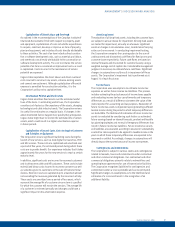Cogeco 2004 Annual Report Download - page 21
Download and view the complete annual report
Please find page 21 of the 2004 Cogeco annual report below. You can navigate through the pages in the report by either clicking on the pages listed below, or by using the keyword search tool below to find specific information within the annual report.
MANAGEMENT’S DISCUSSION AND ANALYSIS
Cogeco Cable Inc. 2004 19
During fiscal 2005, the increase in capital expenditures will
stem mainly from a $16 million increase in the upgrade program,
essentially for bandwidth expansion to 750 MHz and 550 MHz
(for Ontario and Québec systems, respectively) and for reliability
improvements on the network (namely for network standby pow-
ering). The capital expenditure budget also includes $5 million
for the launch of IP telephony.
In the coming years, capital expenditures and subsidies related to
customer premise equipment are expected to decrease as unit
prices continue to decline and as such devices are increasingly
integrated in Consumer Electronics products such as PCs, television
sets and DVDs.
GOING FORWARD, NUMEROUS TECHNOLOGY ADVANCEMENTS
WILL HELP REDUCE CAPITAL EXPENDITURES AND IMPROVE
THE RELIABILITY AND QUALITY OF SERVICES OFFERED.
On the network side, numerous technology advancements will
also help reduce capital expenditures in general. Improvements in
compression and multiplexing techniques will continue to occur,
as they did significantly in the past few years, and will allow for
more and more video signals to be transmitted within a given
bandwidth without signal degradation. A good part of the increased
bandwidth needs, generated by growth in narrowcast digital
services such as Internet and VOD, will be accommodated through
further cost efficient node splitting. The eventual migration to
DOCSIS 2.0 will allow for the use of more robust modulation tech-
niques in the return path. Most importantly, the gradual migration
of cable systems to all-digital networks will allow operators to
recuperate the bandwidth currently used for analog distribution
and use it for digital signals distribution, including HD television
signals. This migration to all digital systems will take some time
to complete and capacity upgrades will require 3 to 5 years. As a
result, capacity upgrades will consume relatively less capital than
has been the case in the past, and increasingly, upgrades will be
targeted at improvements in quality and reliability of services.
Increase in Deferred Charges
Increase in deferred charges declined to $20 million in fiscal 2004
compared to $22.1 million in fiscal 2003. The breakdown of the
increase in deferred charges is presented in the table below.
Years ended August 31, 2005 2004 2003
(in thousands of dollars) Guidelines
(1)
(restated)
$$$
Equipment subsidies 3,000 9,532 10,280
Reconnection costs 9,300 10,490 10,371
New services launch
costs and others 0 01,445
12,300 20,022 22,096
(1)
See the “Fiscal 2005 Financial Guidelines” section on page 24 for
further discussion.
Costs associated with the launch of new services mainly relate
to the rollout of VOD service in fiscal 2003. Equipment subsidies
relate to subsidies on sales of 56,798 and 50,946 digital terminals
in fiscal 2004 and 2003, respectively. During fiscal 2005, a signif-
icant reduction in the increase in deferred charges is planned,
as Cogeco Cable launched an attractive digital terminal rental
plan last June and August in Ontario and Québec, respectively.
Furthermore, an anticipated decline in unit cost should further
contribute to lower equipment subsidies.
Free Cash Flow and Financing Activities
Free Cash Flow of $43.5 million was generated during fiscal 2004,
an increase of $41.1 million over fiscal 2003 as a result of increas-
ing cash flow from operations and declining capital expenditures
and deferred charges.
In fiscal 2004, long-term debt and bank indebtedness declined by
$50.9 million essentially due to Free Cash Flow of $43.5 million
and an increase in non-cash working capital items and long-term
deferred and prepaid income of $4.3 million. In fiscal 2003,
long-term debt and bank indebtedness declined by $22.8 million
essentially due to an increase in non-cash working capital items
and long-term deferred and prepaid income of $19.6 million and
Free Cash Flow of $2.4 million.
Cogeco Cable declared a quarterly dividend during the first quarter
of fiscal 2005 for the first time since fiscal 2001 as a result of a
significant improvement in its financial results leading to strong
Free Cash Flow. On October 15, 2004, a quarterly dividend of $0.02
per share was declared for holders of subordinate and multiple
voting shares.
























